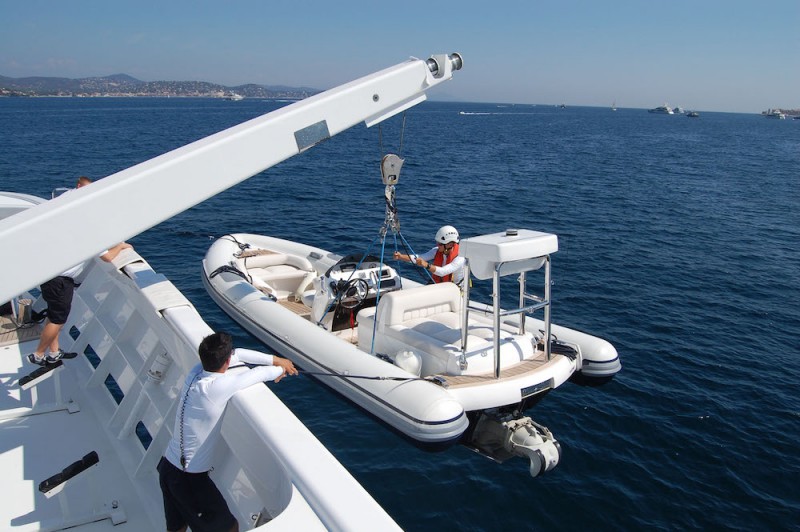Harness safety: ignored or misunderstood?
How often do you walk down a dock and see a superyacht crewmember hanging overside, with no harness, no life jacket and no hard hat? In issue 79 of The Crew Report, we take a look at where harness safety fits into on-board safety culture.…
In the superyacht industry, we have guidance and we have regulations. Or rather, we should have. Unfortunately, when it comes to working aloft or overside (whatever you want to call it), we have only guidance. Whether regulations would result in a change in accident and fatality figures is something on which we cannot yet comment, yet it is surprising, given the number and nature of accidents in recent years, that today we are not required, but merely guided.
There are two prominent documents that outline how overside work on a vessel should be undertaken. The first is chapter 17 of the Code of Safe Working Practices, which instructs, “Personnel working aloft should wear a safety harness with a lifeline or other arresting device at all times”. In Annex 17.3, advice includes the necessity of a system compromising at least two separately anchored ropes (a working rope and a safety rope), a suitable harness, safe means of ascent and descent, self-locking systems and mobile fall prevention systems connected to the crewmember, to name just a few. The second, from the Maritime and Coastguard Agency (MCA), is MGN 422, entitled Use of Equipment to Undertake Work Over the Side of Yachts and Other Vessels. And the notice is quick to make clear its legal status, or rather lack of, immediately declaring, “Where this document provides guidance on the law it should not be regarded as definitive”. MGN 422 is no 100-page Maritime Labour Convention, 2006 (MLC); MGN 422 is a mere six pages – easy reading for any crewmember. Section three focuses on operation, which is where many feel the discussion on safety harnesses should be focused and, perhaps most importantly, section 3.1 dictates: ‘the manufacturers’ instructions are read and understood by the persons who will be using the equipment; a risk assessment is carried out and appropriate rescue plan developed to recover persons who fall into the water; and crewmembers are competent to use the equipment’. These are three instructions that should appear all too obvious, yet seemingly not for yacht crew. “Not knowing the procedure and process is a big problem. Does every crewmember hanging off the side of the yacht actually know what they’re meant to be doing? I genuinely don’t think they do,” admits Geoff Moore, managing director at West Nautical. “When we conduct our ISM audits, we speak to the crew responsible for conducting these tasks and ask them to tell us how they would start the process of working aloft, and there are always mistakes. They’re meant to know what they’re doing, and have signed permits to work in the past, so why don’t they?”
So much of this comes down to a superyacht’s safety culture and, unfortunately, the practices of the superyacht industry are a far cry from any examples we should be following. This can be quickly recognised in something as simple as clothing. Think safety shoes, hard hats, boiler suits – otherwise known as PPE equipment, always seen on commercial ships and oil rigs. This visually makes you think ‘safety first’, yet what do we see on superyachts? Shoes are taken off before you even step on board, shorts, T-shirts and skorts, and the hardest item on a crewmember’s head is their Ray-Bans. But you know what you’re doing, right? These accidents are so rare, what’s the chance of them happening to you? Unfortunately, it’s this attitude that is arguably causing the most problems. Moore points to perhaps the most talked-about accident of the superyacht sector – Kibo. “The person who went over the side wasn’t trained to do it. They weren’t wearing the right equipment; they weren’t secured in the correct way. That boat is a fully commercial, compliant yacht, with proper officers, proper documentation, a proper management company, yet the accident still happened,” he says.
A humbleness needs to be called for, a humbleness that means captains start to acknowledge that accidents do happen, despite one’s best efforts at safety. The ‘that won’t happen on my boat’ attitude is wholly unhelpful. “That’s what the captain of Kibo would have said the day before. It was a good boat, with everything in place, and it still managed to happen,” adds Moore. “People need to be able to say, ‘Let’s think about why it wouldn’t happen on our boat, with our procedures and rules. So let’s get everyone together and talk about it’. But that takes time and effort, and safety, unfortunately, is not the number-one priority on a lot of yachts.”
Find the full article in issue 79 of The Crew Report, available at the Monaco Yacht Show.
Profile links
NEW: Sign up for SuperyachtNewsweek!
Get the latest weekly news, in-depth reports, intelligence, and strategic insights, delivered directly from The Superyacht Group's editors and market analysts.
Stay at the forefront of the superyacht industry with SuperyachtNewsweek
Click here to become part of The Superyacht Group community, and join us in our mission to make this industry accessible to all, and prosperous for the long-term. We are offering access to the superyacht industry’s most comprehensive and longstanding archive of business-critical information, as well as a comprehensive, real-time superyacht fleet database, for just £10 per month, because we are One Industry with One Mission. Sign up here.
NEW: Sign up for
SuperyachtNewsweek!
Get the latest weekly news, in-depth reports, intelligence, and strategic insights, delivered directly from The Superyacht Group's editors and market analysts.
Stay at the forefront of the superyacht industry with SuperyachtNewsweek




